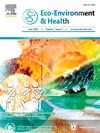Synergistic strategies for pollution and carbon emission reduction in China's wastewater treatment: A comprehensive tiered assessment and benchmarking framework
IF 17.6
引用次数: 0
Abstract
China's dual-carbon goals challenges wastewater treatment plants (WWTPs), requiring integrated pollution control and carbon emission reduction. Critical gaps hinder China's strategies for WWTPs, particularly in identifying upgrade needs, optimizing performance, and assessing the local benchmark plants as references. This study addresses these gaps through greenhouse gas (GHG) emission accounting and impact factor analysis, using monthly data from 2232 WWTPs across China. A tiered assessment methodology was developed to evaluate the synergy between pollution reduction and carbon mitigation, including indicators, methodologies, and assessment criteria. Results indicate that indirect emissions from electricity and chemical consumption accounted for 59.9% of total GHG emissions. Key factors influencing these indirect emissions included plant scale, treatment processes, geographic area, operational load, electricity consumption, and influent quality. Through the tiered assessment, WWTPs were classified into three categories: priority control (861 plants), general control (730 plants), and maintenance (641 plants). Furthermore, 222 benchmark plants were identified as exhibiting optimal synergy between pollution control and carbon reduction. For 80% of the benchmark plants, the ranges for carbon emission intensity, influent COD, influent C/N ratio, electricity consumption intensity, and operating load were 0.258–0.482 kg CO2e/t, 175–338 mg/L, 6.13–10.9, 0.149–0.260 kWh per tonne of influent, and 88.0%–110%, respectively. Achieving these benchmark standards across all WWTPs could lead to a 30% reduction in total GHG emissions. Finally, the study proposes targeted policies to enhance the synergy between pollution control and carbon reduction strategies in China's urban wastewater treatment systems.

中国污水处理中污染和碳减排的协同战略:一个综合分级评估和标杆框架
中国的双碳目标对污水处理厂(WWTPs)提出了挑战,需要综合治理污染和减少碳排放。关键的差距阻碍了中国的污水处理厂战略,特别是在确定升级需求、优化性能和评估当地基准工厂作为参考方面。本研究利用中国2232个污水处理厂的月度数据,通过温室气体(GHG)排放核算和影响因子分析来解决这些差距。制定了一套分级评估方法,以评估减少污染和减少碳排放之间的协同作用,包括指标、方法和评估标准。结果表明,电力和化学品消费的间接排放占温室气体排放总量的59.9%。影响这些间接排放的关键因素包括工厂规模、处理过程、地理区域、运行负荷、电力消耗和进水质量。通过分级评价,将污水处理厂划分为优先控制(861座)、一般控制(730座)和维护(641座)三类。此外,222家基准工厂在污染控制和碳减排之间表现出最优的协同效应。80%的基准电厂碳排放强度、进水COD、进水C/N比、用电强度和运行负荷分别为0.258 ~ 0.482 kg CO2e/t、175 ~ 338 mg/L、6.13 ~ 10.9、0.149 ~ 0.260 kWh /t和88.0% ~ 110%。在所有污水处理厂实现这些基准标准可使温室气体排放总量减少30%。最后,本研究提出了有针对性的政策建议,以增强中国城市污水处理系统中污染控制与碳减排战略之间的协同效应。
本文章由计算机程序翻译,如有差异,请以英文原文为准。
求助全文
约1分钟内获得全文
求助全文
来源期刊

Eco-Environment & Health
环境科学与生态学-生态、环境与健康
CiteScore
11.00
自引率
0.00%
发文量
18
审稿时长
22 days
期刊介绍:
Eco-Environment & Health (EEH) is an international and multidisciplinary peer-reviewed journal designed for publications on the frontiers of the ecology, environment and health as well as their related disciplines. EEH focuses on the concept of “One Health” to promote green and sustainable development, dealing with the interactions among ecology, environment and health, and the underlying mechanisms and interventions. Our mission is to be one of the most important flagship journals in the field of environmental health.
Scopes
EEH covers a variety of research areas, including but not limited to ecology and biodiversity conservation, environmental behaviors and bioprocesses of emerging contaminants, human exposure and health effects, and evaluation, management and regulation of environmental risks. The key topics of EEH include:
1) Ecology and Biodiversity Conservation
Biodiversity
Ecological restoration
Ecological safety
Protected area
2) Environmental and Biological Fate of Emerging Contaminants
Environmental behaviors
Environmental processes
Environmental microbiology
3) Human Exposure and Health Effects
Environmental toxicology
Environmental epidemiology
Environmental health risk
Food safety
4) Evaluation, Management and Regulation of Environmental Risks
Chemical safety
Environmental policy
Health policy
Health economics
Environmental remediation
 求助内容:
求助内容: 应助结果提醒方式:
应助结果提醒方式:


